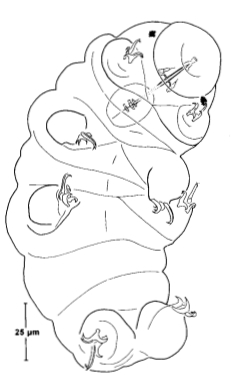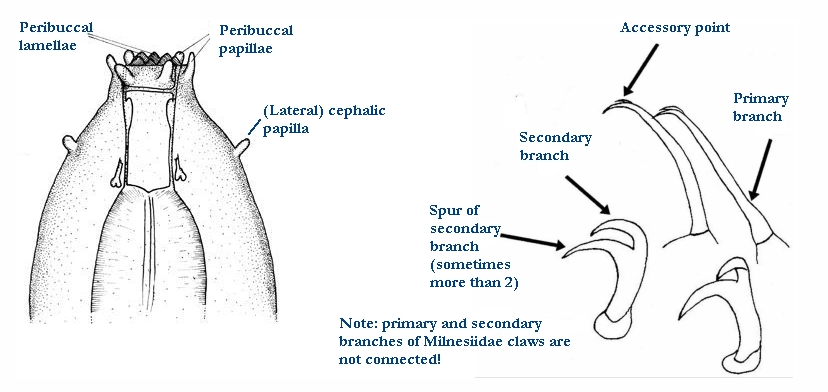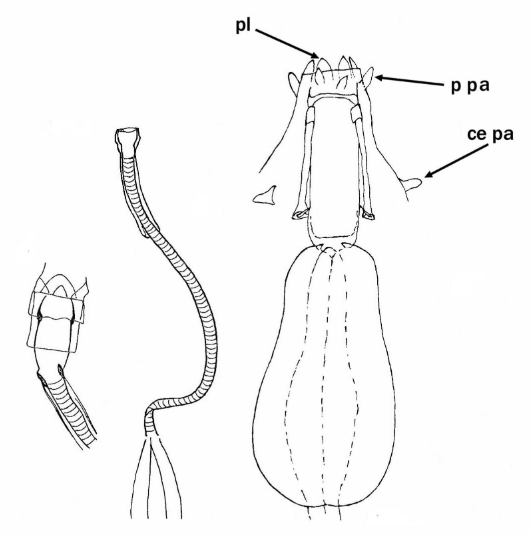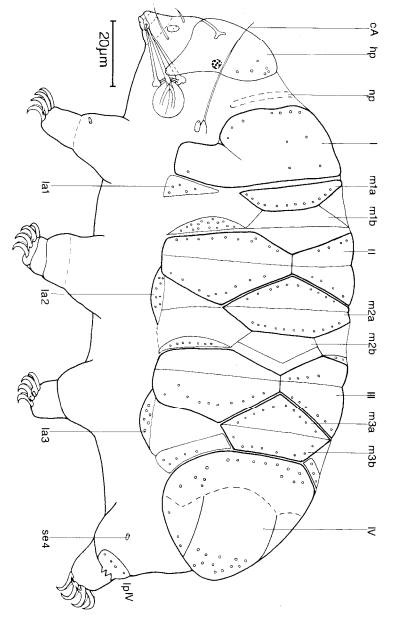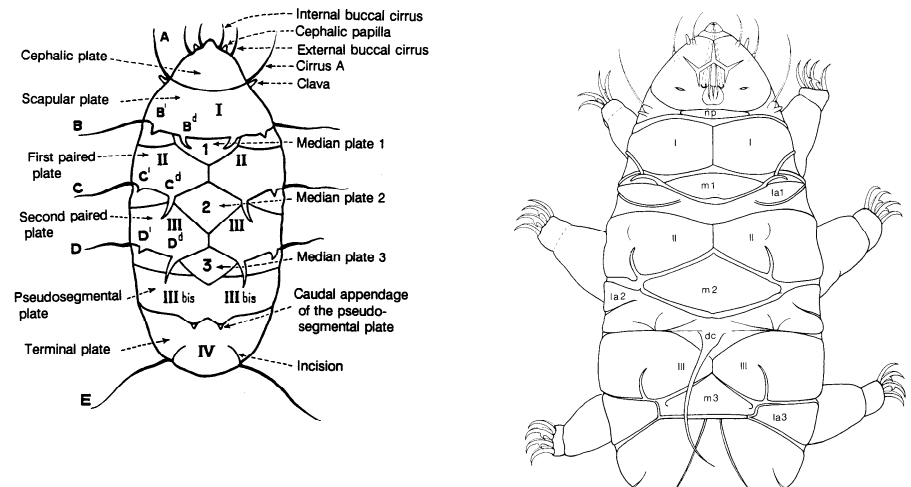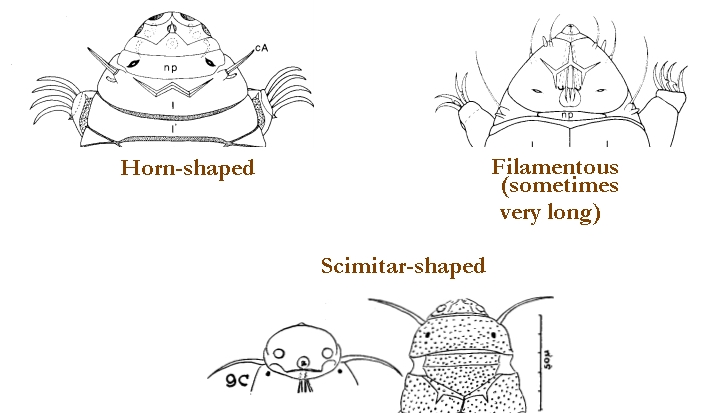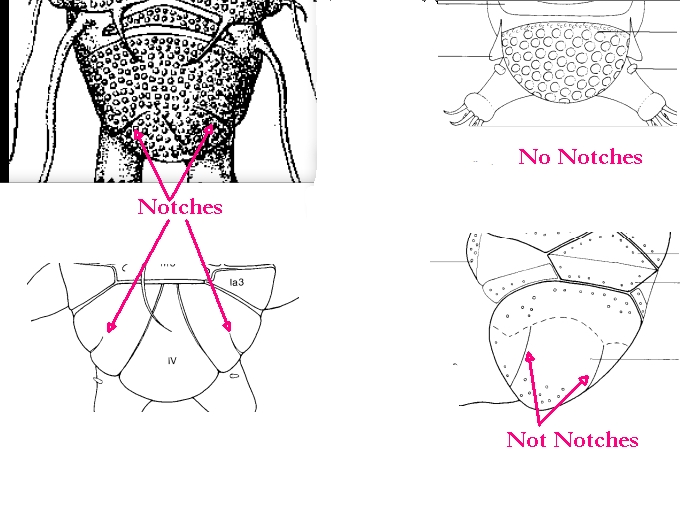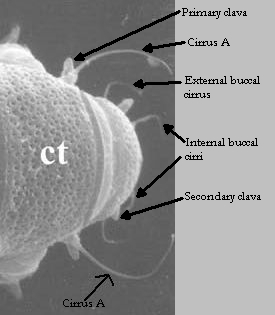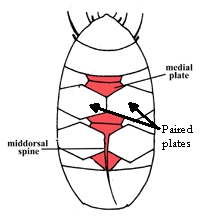Genus Pseudobiotus
Isohypsibioidea from Marley et al. 2011: “Parachela. Claws asymmetrical (2121); Isohypsibius-type claw pairs; AISM ridged.”
Isohypsibioidea from Bertolani et al. 2014: “Double claws asymmetrical with respect to the median plane of the leg (2121), normally with similar shape and size on each leg; double claws of the Isohypsibius type (secondary branch of the external claw inserted perpendicularly on the claw basal tract), or reduced from it: Hexapodibius type (very short, without common basal tract, with a base as large as the sum of the primary and secondary branch widths, and with an evident suture between primary and secondary branch); Haplomacrobiotus type (one branch only); completely absent (Apodibius). Buccal tube completely rigid (apart Paradiphascon; see below) and often relatively large, without (Dastychius, Eremobiotus, Halobiotus, Isohypsibius, Paradiphascon, Pseudobiotus, Thulinius) or with (Apodibius, Doryphoribius, Haplomacrobiotus, Haplohexapodibius, Hexapodibius, Parhexapodibius) ventral lamina. Eggs with smooth shell laid within the exuvium.”
Isohypsibiidae from Marley et al. 2011: “Isohypsibioidea. Claw pairs of similar size and shape. External and internal claws exhibiting articulation (the basal section and secondary branch form a solid unit while the primary branch and secondary branch articulate). Claws Isohypsibius-type, forming a right-angle between basal section and secondary branch. AISM ridge-like.”
Genus description from Schuster et al. 1980: “thirty small, irregular buccal lamellae present; peribuccal papulae absent. Buccal tube short, rigid, without spiraled thickenings; mucrones present. Buccal tube has anterior dorsal and ventral thickenings or crests. Pharynx with apophyses and macroplacoids; without microplacoids or septulum. Two double claws of each leg of similar size and shape; branches not connected; lunules absent; sequence alternate 2,1,2,1. Smooth eggs deposited in the cuticle.
Discussion: The presence of buccal lamellae and the dorsal and ventral anterior thickenings of the buccal tube distinguish species of Pseudobiotus.”
Key from Chang et al, 2007. Missing: [Pseudobiotus longiunguis (Iharos, 1968) is omitted here, for its taxonomic position is still unclear.] Also, n sp. of Nelson & Bartels
1.Cuticular surface smooth, without cuticular spines/spicules …………………………………………………………………………… 3
-Cuticular surface with cuticular spines/spicules…………2
2.Spines/spicules small (1.5–2.5 µm long) only in anterior and posterior part of the body; accessory points eminent at the end of primary branches; eyes absent……………… ……………………………………………………………..
P. vladimiri -Spines/spicules relatively large (up to 5.0 µm long) on whole dorsal side of the body; accessory points very small, visible only with SEM, nearly in the middle of primary branches; eyes present…………………..P. spinifer sp. nov.
3.Two macroplacoids present…………………..P. megalonyx
-Three macroplacoids present………………………………….4
4.Accessory points on primary branches and papillae on legs I–III absent; primary branches connected with rest of claw by very thin structure sometimes not visible; eyes absent………………………………………………………. P. matici
-Accessory points on primary branches and papillae on legs I-III present; primary branches clearly connected with rest of claw; eyes present………………P. kathmanae
Citations :
Pseudobiotus image cropped from Nelson DR, Marley NJ, Bertolani R. 1999. Re-description of the genus Pseudobiotus (Eutardigrada, Hypsibiidae) and of the new type species Pseudobiotus kathmanae sp. n. Zoolgischer Anzeiger. 238: 311-317.
“Parts” images rom Pilato G, Binda MG. 2010. Definition of families, subfamilies, genera, and subgenera of the Eutardigrada, and keys to their identification. Zootaxa. 2404: 1-54.
Bertolani R, Guidetti R, Marchioro T, Altiero T, Rebecchi L, Cesari M. 2014. Phylogeny of Eutardigrada: New molecular data and their morphological support lead to the identification of new evolutionary lineages. Molecular Phylogenetics and Evolution. 76: 110-126.
Marley NJ, McInnes SJ, Sands CJ. 2011. Phylum Tardigrada: A re-evaluation of the Parachela. Zootaxa. 2819: 51-64.
Pilato G, Binda MG. 1996. Additional remarks to the description of some genera of eutardigrades. Bollettino delle Sedute della Accademia Gioenia di Scienze Naturali in Catania. 29 (351): 33-40.
Schuster RO, Nelson DR, Grigarick AA, Christenberry D. 1980. Systematic criteria of the Eutardigrada. Transactions of the American Microscopical Society. 99: 284-303.
